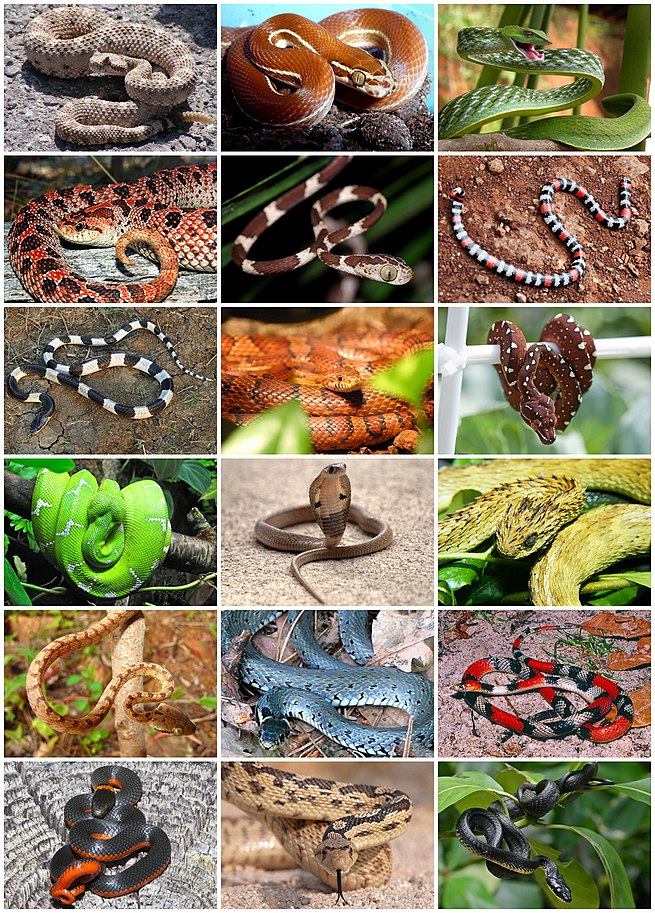
Main Difference
The main difference between Snake and Lizard is that the Snake is a wiggling animal without legs and Lizard is a suborder of reptiles
-
Snake
Snakes are elongated, legless, carnivorous reptiles of the suborder Serpentes. Like all squamates, snakes are ectothermic, amniote vertebrates covered in overlapping scales. Many species of snakes have skulls with several more joints than their lizard ancestors, enabling them to swallow prey much larger than their heads with their highly mobile jaws. To accommodate their narrow bodies, snakes’ paired organs (such as kidneys) appear one in front of the other instead of side by side, and most have only one functional lung. Some species retain a pelvic girdle with a pair of vestigial claws on either side of the cloaca. Lizards have evolved elongate bodies without limbs or with greatly reduced limbs about twenty five times independently via convergent evolution, leading to many lineages of legless lizards. Legless lizards resemble snakes, but several common groups of legless lizards have eyelids and external ears, which snakes lack, although this rule is not universal (see Amphisbaenia, Dibamidae, and Pygopodidae).
Living snakes are found on every continent except Antarctica, and on most smaller land masses; exceptions include some large islands, such as Ireland, Iceland, Greenland, the Hawaiian archipelago, and the islands of New Zealand, and many small islands of the Atlantic and central Pacific oceans. Additionally, sea snakes are widespread throughout the Indian and Pacific Oceans. More than 20 families are currently recognized, comprising about 520 genera and about 3,600 species. They range in size from the tiny, 10.4 cm (4.1 in)-long thread snake to the reticulated python of 6.95 meters (22.8 ft) in length. The fossil species Titanoboa cerrejonensis was 12.8 meters (42 ft) long. Snakes are thought to have evolved from either burrowing or aquatic lizards, perhaps during the Jurassic period, with the earliest known fossils dating to between 143 and 167 Ma ago. The diversity of modern snakes appeared during the Paleocene period (c 66 to 56 Ma ago). The oldest preserved descriptions of snakes can be found in the Brooklyn Papyrus.
Most species are nonvenomous and those that have venom use it primarily to kill and subdue prey rather than for self-defense. Some possess venom potent enough to cause painful injury or death to humans. Nonvenomous snakes either swallow prey alive or kill by constriction.
-
Lizard
Lizards are a widespread group of squamate reptiles, with over 6,000 species, ranging across all continents except Antarctica, as well as most oceanic island chains. The group is paraphyletic as it excludes the snakes and Amphisbaenia which are also squamates. Lizards range in size from chameleons and geckos a few centimeters long to the 3 meter long Komodo dragon.
Most lizards are quadrupedal, running with a strong side-to-side motion. Others are legless, and have long snake-like bodies. Some such as the forest-dwelling Draco lizards are able to glide. They are often territorial, the males fighting off other males and signalling, often with brightly colours, to attract mates and to intimidate rivals. Lizards are mainly carnivorous, often being sit-and-wait predators; many smaller species eat insects, while the Komodo eats mammals as big as water buffalo.
Lizards make use of a variety of antipredator adaptations, including venom, camouflage, reflex bleeding, and the ability to sacrifice and regrow their tails.
-
Snake (noun)
A legless reptile of the sub-order Serpentes with a long, thin body and a fork-shaped tongue.
-
Snake (noun)
A treacherous person.
-
Snake (noun)
A tool for unclogging plumbing.
-
Snake (noun)
A tool to aid cable pulling.
-
Snake (noun)
trouser snake; the penis
-
Snake (noun)
A series of Bézier curves
-
Snake (noun)
The seventh Lenormand card.
-
Snake (verb)
To follow or move in a winding route.
“The path snaked through the forest.”
“The river snakes through the valley.”
-
Snake (verb)
To steal slyly.
“He snaked my DVD!”
-
Snake (verb)
To clean using a plumbing snake.
-
Snake (verb)
To drag or draw, as a snake from a hole; often with out.
-
Snake (verb)
To wind round spirally, as a large rope with a smaller, or with cord, the small rope lying in the spaces between the strands of the large one; to worm.
-
Lizard (noun)
Any reptile of the order Squamata that is not a snake, usually having four legs, external ear openings, movable eyelids and a long slender body and tail.
-
Lizard (noun)
Lizard skin, the skin of these reptiles.
-
Lizard (noun)
An unctuous person.
-
Lizard (noun)
A coward.
-
Lizard (noun)
A hand forming a “D” shape with the tips of the thumb and index finger touching (a handshape resembling a lizard), that beats paper and Spock and loses to rock and scissors in rock-paper-scissors-lizard-Spock.
-
Lizard (noun)
A person who idly spends time in a specified place, especially a promiscuous female.
“lounge lizard; lot lizard; beach lizard; truck stop lizard”
